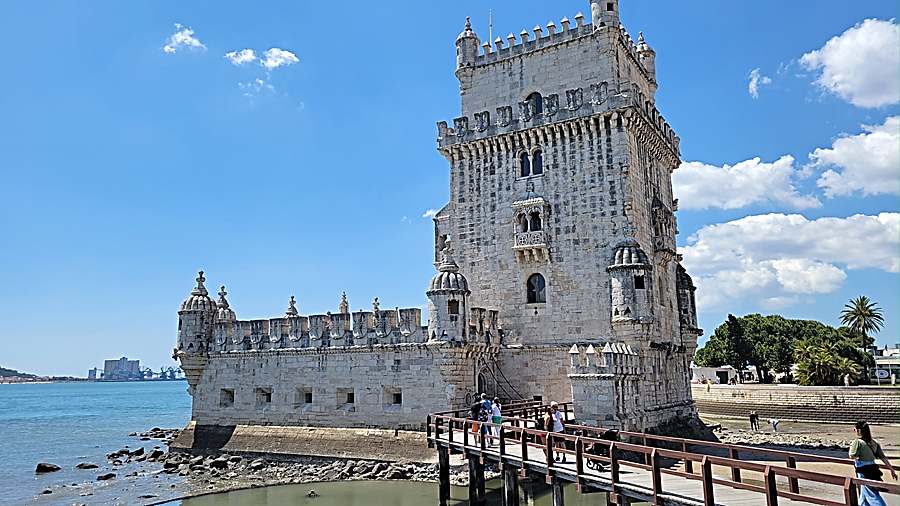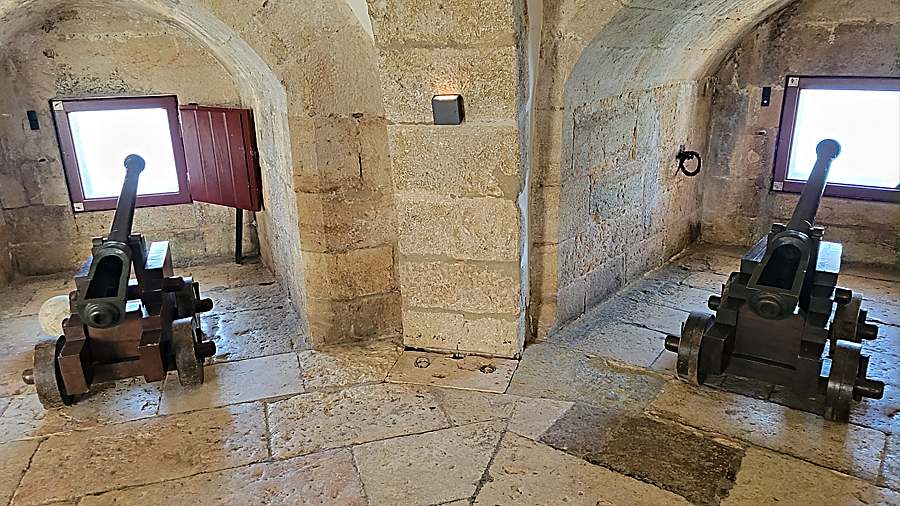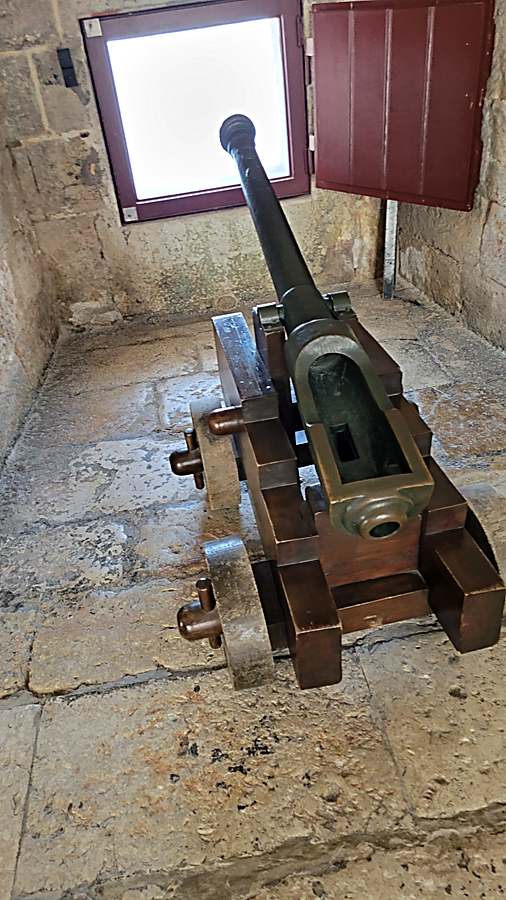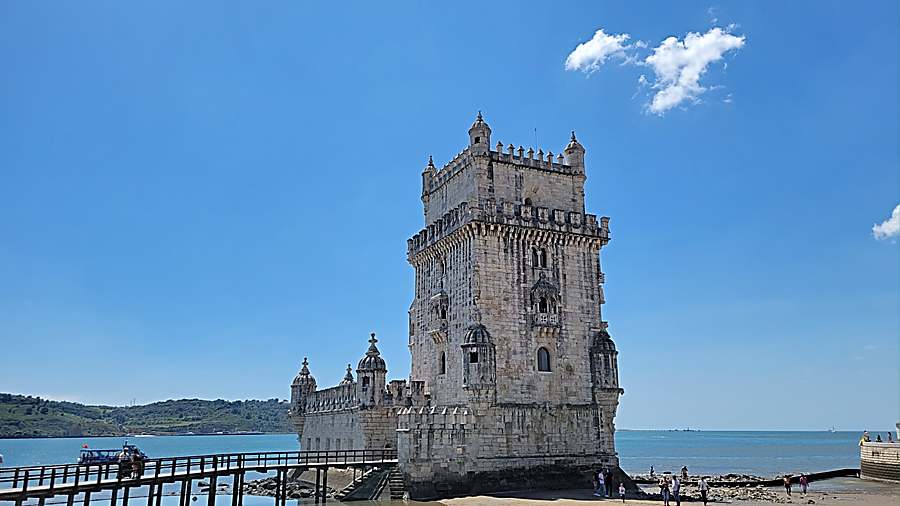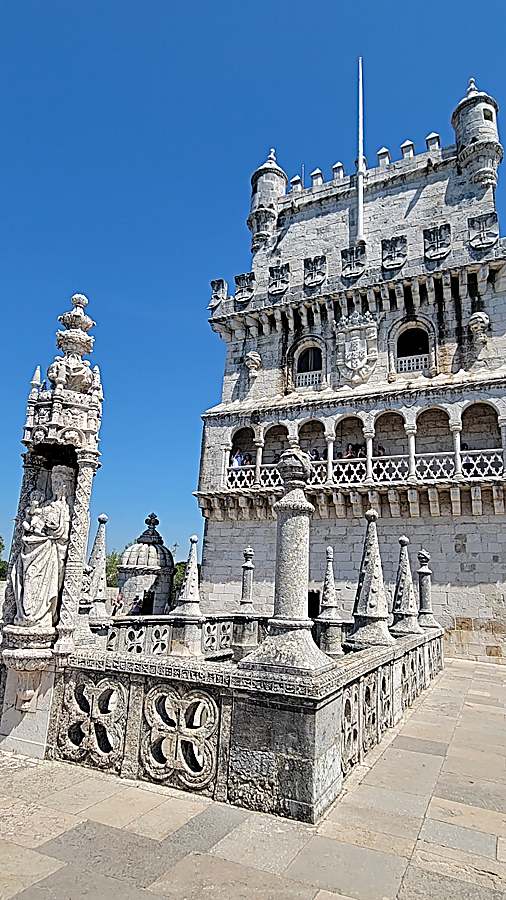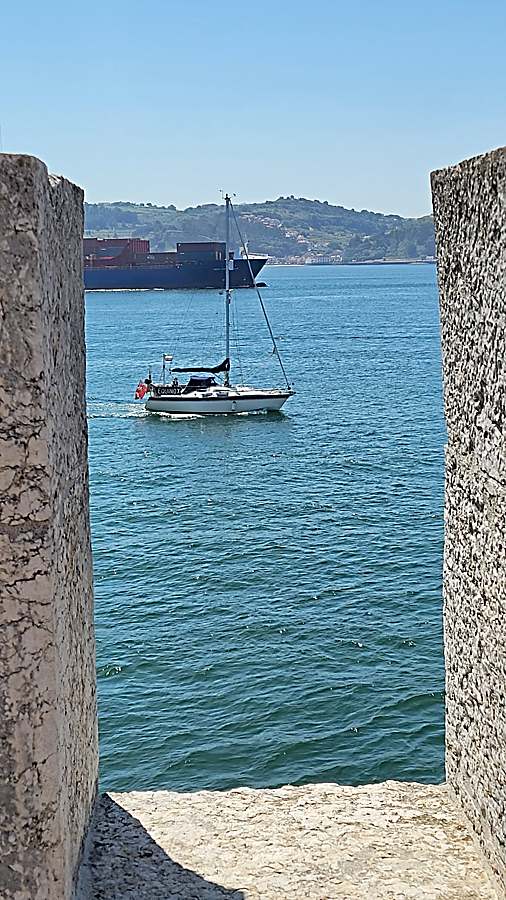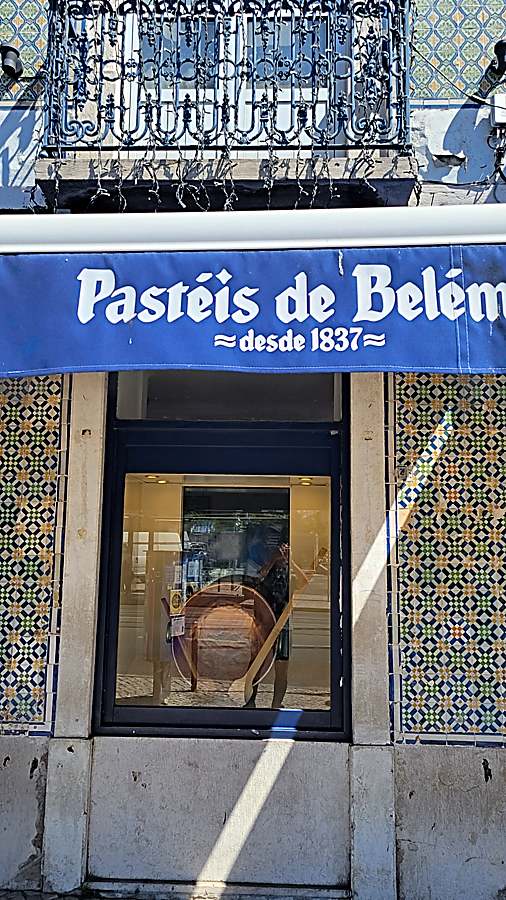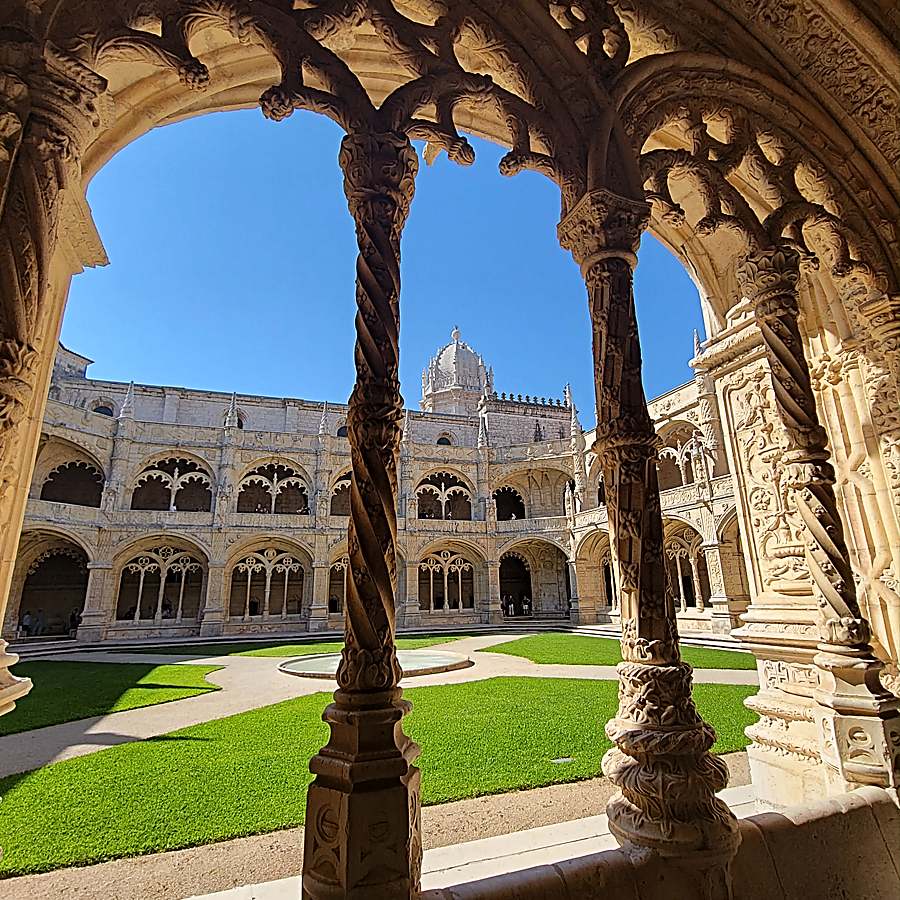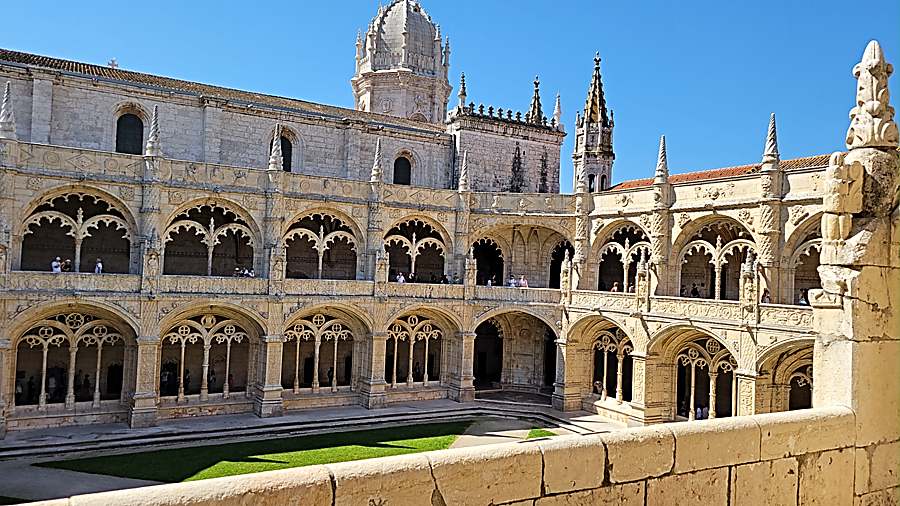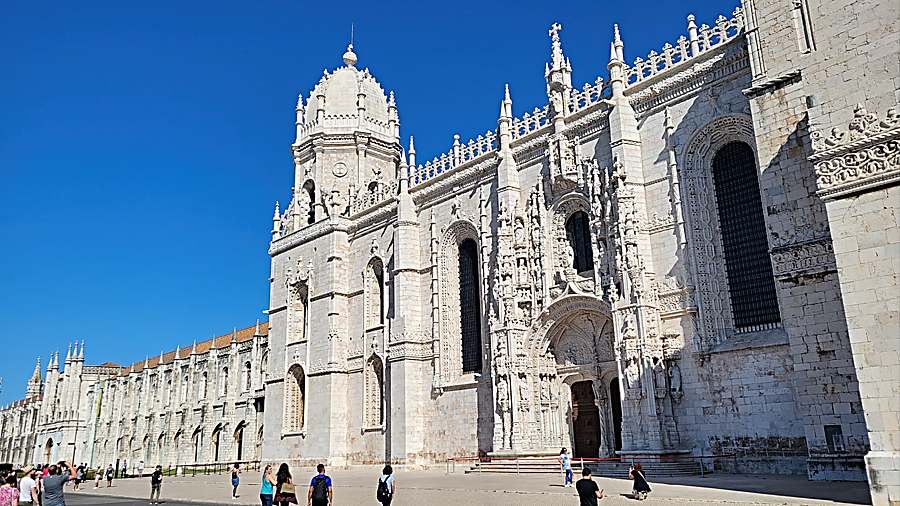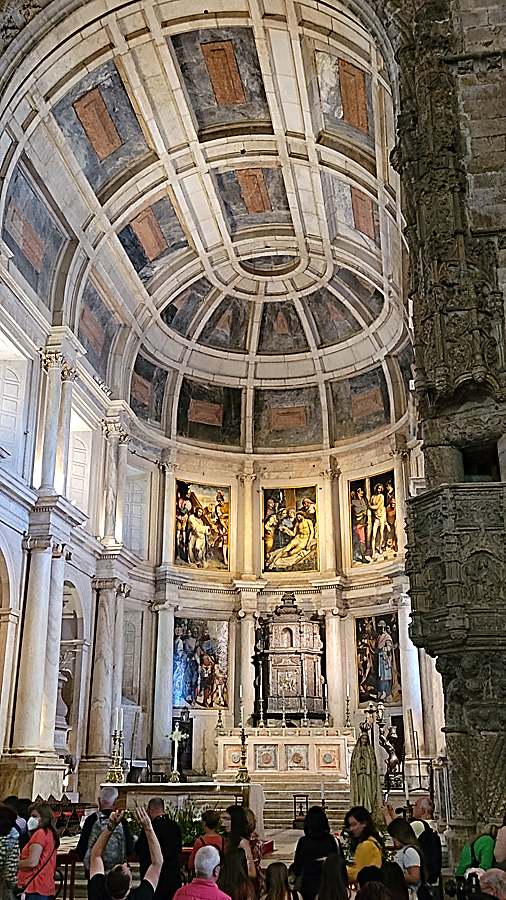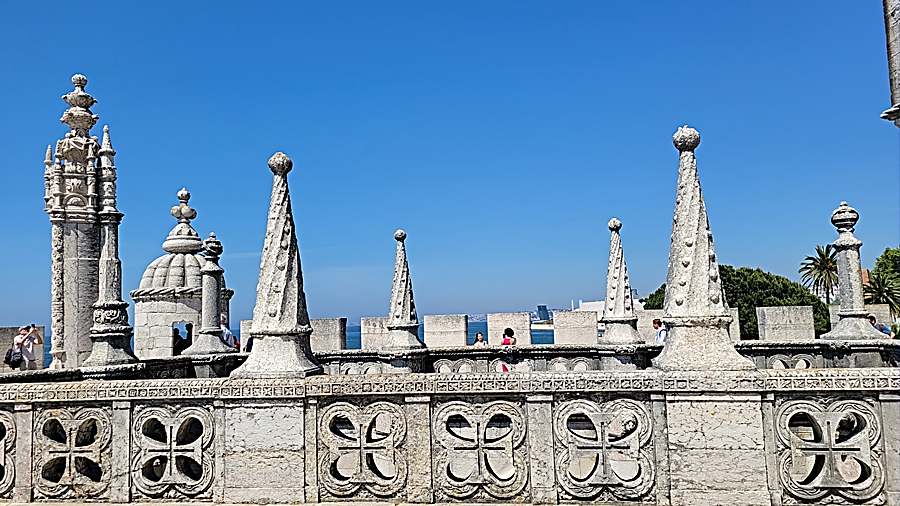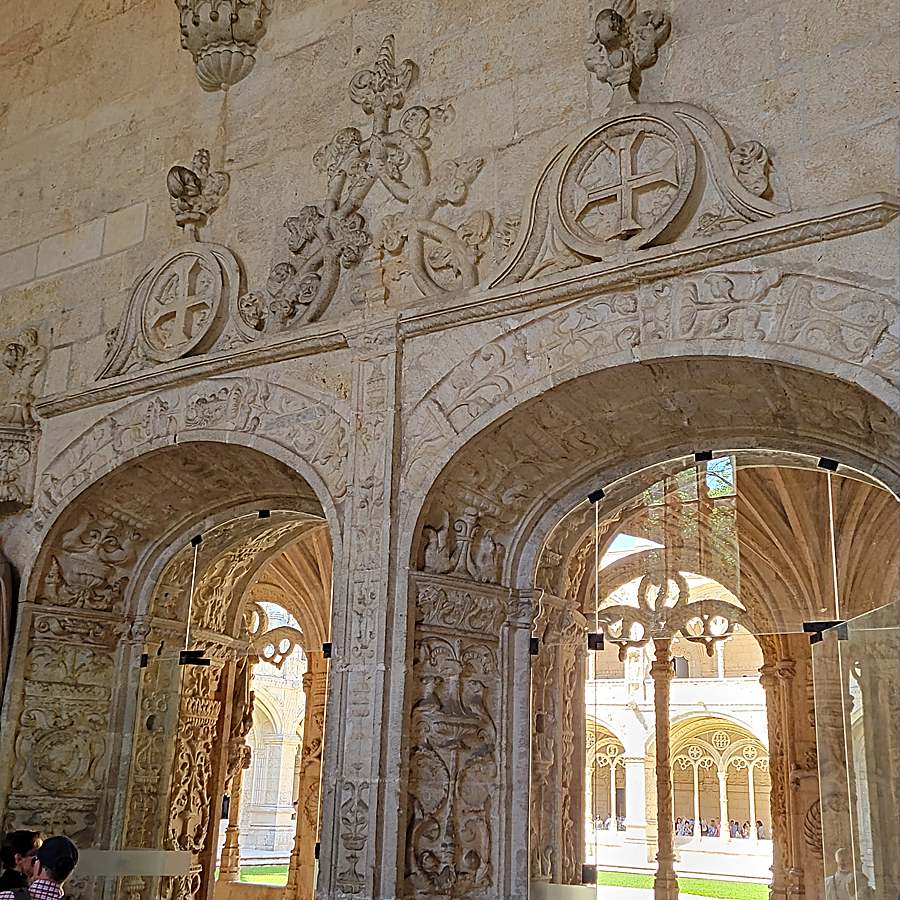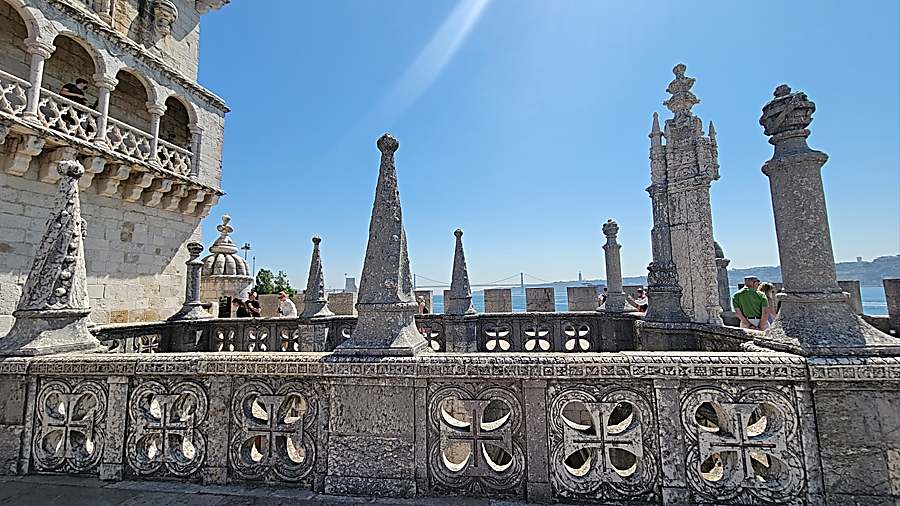Belem Tower in Lisbon: An Iconic Landmark that Chronicles Centuries of History (updated 2023)
One of the most iconic sites in Belem, the Belem Tower or Torre de Belem plays a historic and important role in the defense of the city of Lisbon. The Belem Tower known as Torre de Belem in Portuguese, sits on the waterfront and mouth of the Tagus River as it opens up directly into the Atlantic Ocean.
Known as one of the symbols to Portugal’s expansion into global trade and the Age of Exploration when the Portuguese explorers lead the way to the control and knowledge along with the control over new lands, resources and the people of those new conquests.
The tower of Belem was that first symbol of leaving the old world and discovering new worlds with the master navigators like Vasco de Gama who opened up the world to new trade routes and commerce into India across the Cape of Africa.
When you visit the site, make sure you also get tickets to the inside to check out the elaborate designs and layout, the various rooms and also the spectacular views from the various vantage points and the tower of Belem from above.
You can visit the Monastery of Belem and other attractions with the Lisbon Card here for 1 – 3 days including local transportation.
Where is the Belem Tower located in Lisbon
The Belem Tower is located in Lisbon, Portugal, along the banks of the Tagus River. It stands proudly in the historic district of Belem and is a symbol of Portugal’s maritime history.
The Belem Tower is approximately 6 kilometers (about 3.7 miles) west of downtown Lisbon, making it a relatively short distance to travel from the city center. You can easily reach it by car, tram, or public transportation.
Explore Belem Tower: A Glimpse into Portugal’s Rich Maritime History
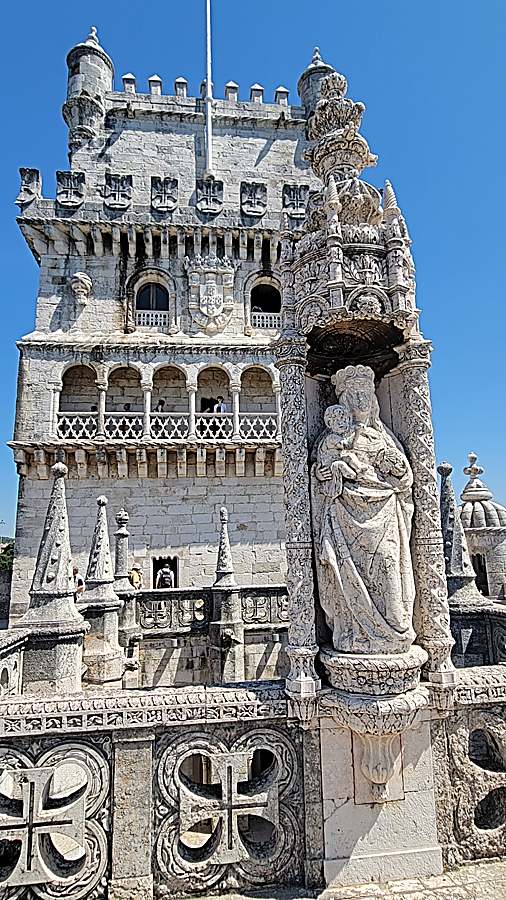
Belem tower, observation area
History of the Belem Tower – Torre de Belem
The Tower of Belem was created in the 16th century originally as a defense for the city and later turned into a lighthouse, dungeon and prison and then a customs center. The Tower is also known as the Tower of Saint Vincent, in honor of Lisbon’s patron saint.
Built between 1514 and 1520 the Belem Tower or Torre de Belem was built in the ornate Gothic – Manueline style by the Portuguese architect, sculptor Francisco de Arruda. This was created during Portugal’s Renaissance and incorporates a four-story tower to the base of the structure. Made with local limestone, a beige colored stone that is called Lioz, the building incorporates the lower bastion or fortress with the four-story tower on the north side.
During the time frame of the Portuguese explorers to the new world routes, the tower was used as a point of embarkation and disembarkation.
Later, the tower was used as a dungeon and prison, a lighthouse and then a customs center. Eventually the Belem tower was designated as a UNESCO World Heritage site in 1983 along with the Jeronimos Monastery to symbolize the Age of Discoveries.
Portugues discoveries and maritime wealth
Portugal’s ocean discoveries abroad played a significant role in shaping the course of world history. During the Age of Discovery, Portuguese explorers embarked on daring voyages that led to groundbreaking maritime achievements. They ventured into uncharted waters, discovering new lands, establishing trade routes, and establishing colonies across the globe.
One of the most notable Portuguese explorers was Vasco da Gama, who successfully sailed around the Cape of Good Hope to reach India in 1498, opening up direct trade between Europe and Asia. This groundbreaking voyage paved the way for Portugal’s dominance in the spice trade and established their reputation as skilled navigators.
Portuguese explorers also discovered and colonized territories such as Brazil, Mozambique, Angola, and Guinea-Bissau, leaving a lasting influence on language, culture, and architecture in these regions. Additionally, they charted and mapped extensive parts of the African and Asian coastlines, expanding geographical knowledge and aiding future explorations.
These ocean discoveries abroad brought wealth, prestige, and influence to Portugal, as well as significant advancements in cartography, navigation, and shipbuilding. They marked a pivotal period in European history, transforming Portugal into a global maritime power and contributing to the era of European colonization and trade domination. The legacy of Portugal’s ocean discoveries remains a testament to their seafaring prowess and enduring impact on the modern world.
What is the best time to visit the Belem Tower
The best time to visit the Belem Tower is during the morning hours or late afternoon. By arriving early in the day, you can beat the crowds and have a more peaceful experience exploring the tower and its surroundings. Alternatively, visiting in the late afternoon allows you to witness the tower’s captivating views during sunset, casting a beautiful glow over the historical site. Avoiding peak hours, such as midday, can help you fully appreciate the architectural marvel and immerse yourself in its rich historical significance.
Visit the interiors of the Belem Tower – Torre de Belem
You can enter and explore the Belem Tower and the cool interior rooms and museum collections with an entry of 6 Euro.
When you enter the ground floor, there are 16 windows with openings for cannons which were used for defense of the city. You can also check out the pits and dungeon area of the tower where the prisoners were placed.
There is a set of spiral staircases that takes you to the upper level with five different rooms that includes the Governor’s Hall, the Kings’ Hall, the Audience Hall, the Chapel and the Roof Terrace. The ceilings are created in an elaborate rib vaulting structure that showcases the crosses of the Order of Christ and twisted rope that was an organic and Manueline design style.
A fascinating Rhino Gargoyle
There is an impressive gargoyle of a rhino on the western façade of the tower. This was made to showcase the first rhino that was brought to Portugal as a gift to the king and initially placed in the dungeon of the Belem Tower to keep it in a protected area.
Tip – take the narrow spiral stair case all the way to the top of the observation area for fantastic views around the Tagus River all the to the ocean and scenic vistas of the Belem district.
How to get to the Tower of Belem
You can get to the Belem district and visit the Tower of Belem from many points in the historic district via local trams that take about 25 minutes riding around the scenic waterfront area. From the Lisbon waterfront plaza, take the local tram number 15 (known as the “Carris 15E” and ask the guide to stop from where you can walk to the tower.
The cost for the ride is 3 Euro each way on the local trams to get to the Belem Tower, you can also get a receipt to get off the tram and back on within a certain timeframe.
How much is it going to cost to visit Belem Tower and local attractions?
Entry to Belem Tower 6 Euro
Check out the official website here for more infomation.
Other things to try or explore in the area
Church of the Belem Monastery
The Church of the Belem Monastery, also known as the Jeronimos Monastery, is a historical and iconic religious building located in Belem, Lisbon, Portugal. It is a prime example of the Manueline style, a unique Portuguese architectural style characterized by intricate ornamentation and maritime motifs. The monastery was constructed in the 16th century, commissioned by King Manuel I to commemorate Vasco da Gama’s successful sea voyage to India.
The exterior of the Church of the Belem Monastery boasts stunning facades adorned with detailed stonework, including maritime elements such as ropes, anchors, and sea creatures, reflecting Portugal’s maritime heritage during the Age of Discoveries. The interior is equally impressive, featuring beautiful vaulted ceilings, elegant columns, and exquisite religious artwork.
The church is closely associated with important historical figures, and it has served as a burial site for several prominent Portuguese kings and explorers, further contributing to its significance and grandeur. Today, the Church of the Belem Monastery is a popular tourist attraction, drawing visitors from all over the world to marvel at its rich architectural and historical heritage.
Belem Monastery
The Belem Monastery, also known as the Jeronimos Monastery, is a historic religious building located in Belem, Lisbon, Portugal. It was constructed in the 16th century during the reign of King Manuel I to commemorate the successful sea voyage of Vasco da Gama to India. The monastery showcases the distinctive Manueline architectural style, with intricate stonework and maritime motifs. The interior boasts impressive vaulted ceilings, elegant columns, and religious artwork. It is a significant cultural and historical site, serving as a burial place for Portuguese kings and explorers. Today, the Belem Monastery is a popular tourist attraction, attracting visitors from around the world to admire its beauty and historical significance.
A visit to the monastery grounds and cloister of Belem + Belem Tower 12 Euro
You can get a Visit Lisbon Card to explore the many attractions around the city, check out this card here for more information.
To get to the Belem Tower, take a local tram ride from the main waterfront plaza to Belem area and the cost is 3 Euro for each direction.
Padrão dos Descobrimentos
The Padrão dos Descobrimentos, also known as the Monument to the Discoveries, is a historical landmark located in Belem, Lisbon, Portugal. This iconic monument was built in 1960 to commemorate the 500th anniversary of the death of Henry the Navigator, a prominent figure in the Age of Discoveries.
The monument is shaped like the prow of a ship and stands tall at the edge of the Tagus River. It features a massive stone sculpture depicting various important historical figures from Portugal’s Age of Discoveries period, including explorers, navigators, cartographers, and other key figures who played crucial roles in Portugal’s exploration and maritime achievements during the 15th and 16th centuries.
The Padrão dos Descobrimentos serves as a testament to Portugal’s rich maritime history and exploration legacy, celebrating the country’s significant contributions to the exploration of new lands and cultures. It has become a popular tourist attraction, offering stunning views of the river and the nearby Belem Tower, another important historical landmark in Lisbon.
National Coach Museum
The Coach Museum, also known as the National Coach Museum, is a prominent cultural institution located in Lisbon, Portugal. It houses one of the world’s most extensive and remarkable collections of historical coaches and carriages.
Established in 1905, the museum’s primary purpose is to showcase the opulent carriages once used by Portuguese royalty, aristocrats, and dignitaries from the 17th to the 19th centuries. The collection includes beautifully decorated and intricately designed coaches, some of which were used for ceremonial purposes, travel, or leisure.
Visitors to the Coach Museum can marvel at the exquisite craftsmanship, intricate detailing, and lavish ornamentation of these historical vehicles, providing a fascinating insight into the luxurious transportation of the past. The museum offers a unique opportunity to explore Portugal’s aristocratic heritage and witness the grandeur of a bygone era.
Views from above Belem Tower
Fun things to enjoy around Belem
Outside of visiting the Belem tower, there are some fantastic attractions, historic sites and other fun hang out spots to enjoy around the Belem area.
This includes:
Pasteis de Belem
This popular custard tart was created initially at the nearby Mosteiro dos Jeronimos and was later developed into the more circulated Pasteis de nata. The Pasties de Belem has its bakery close to the Monastery and is a huge operation for visitors to visit and enjoy this pasty along with other delicious pastries and local foods at its premiere location in Belem.
The cost for Pasteis de Belem, a delicious Portuguese pastry, can vary slightly depending on where you purchase them. At the renowned Antiga Confeitaria de Belem in Lisbon, which is the most famous and traditional place to savor these pastries, you can expect to pay around €1.10 to €1.15 per individual pastry.
Monastery of Belem
Close to the Belem Tower is the historic site of the Monastery of Belem which combined is certified as a Unesco World Heritage site. The Monastery of Belem was created in the 16th Century in the order of St. Jerome, the patron saint of the city. Funded by the new trade routes and wealth from the new world discoveries, the Monastery of Belem is gorgeous and elaborate in craftsmanship and details.
The gorgeous monastery is elaborate with two levels of open air rooms surrounding the cloister and interior rooms you are allowed to explore. The cloisters are the highlight here with ornately designed and carved stonework done in the beautiful manueline style. Gorgeous carved details on the stonework, elaborate arches, columns and design motifs stand out and makes this a beautiful space and instagram worthy spot to visit.
Check out our post to visiting the Monastery of Belem here for more inspiration and images on this gorgeous historic site.
If you want to have a guided tour of the Tower and Monastery, check out this fantastic tour here for more information and booking the tour.
Church of Santa Maria at Belem
Located adjoining the Monastery of Belem, the Church of Santa Maria is also created in the typical Gothic Manueline style of the period and is a free site you can visit. The entrance to the church on the western side (usually with long lines that already start forming mid day morning)
Inside you will find the stone tombs of many previous rulers and a small chapel dedicated to Vasco da Gama. The tomb was sculpted in the 19th century and the remains of his body were moved here in 1880, nearly 400 years after he set off from this spot.
Details to visiting the Belem Tower
Hours
October – April: 10 am to 5:30 pm.
May – September: 10 am to 6.30 pm.
Closed: Mondays, 1 January, Easter Sunday, 1 May and 25 December.
Entry Price
Adults: € 6 (US$ 6) (+ Jerónimos Monastery, € 12 (US$ 12); Jerónimos Monastery + Ajuda Palace: € 16 (US$ 16))
Senior (over 65 years old): 50% discount.
Youth Card: 50% discount.
Children (less than 12 years old): free entrance.
Another option is to take a group tour of Belem that let’s the group cut into the line so there’s no long wait to enter. Check out these tours offered below to visiting the Monastery and saving your time instead of waiting in line.
Walking tour of the Monastery and Belem Tower
Half day tour of Belem attractions including Monastery of Belem
Monastery, Belem Tower and LX Factory visit
You can visit the Monastery of Belem and other attractions with the Lisbon Card here for 1 – 3 days including local transportation.
Inside tips to visiting and enjoying the Belem Tower
Here are some inside tips to enhance your visit to the Belem Tower:
Arrive Early: To avoid long queues and crowds, it’s best to arrive early in the day. The Belem Tower is a popular attraction, and being one of the first visitors allows you to explore the site more comfortably.
Plan Sufficient Time: Allocate enough time for your visit to fully appreciate the historical significance and architectural beauty of the Belem Tower. Plan for at least an hour to explore the tower, climb its stairs, and take in the panoramic views from the top.
Explore the Surroundings: While the Belem Tower is a highlight, take the opportunity to explore the surrounding area as well. Stroll along the nearby waterfront promenade, visit the nearby Jeronimos Monastery, and enjoy the scenic views of the Tagus River.
Learn the History: Before visiting, familiarize yourself with the history of the Belem Tower. Understanding its significance as a defensive fortress and symbol of Portugal’s maritime past will enrich your experience.
Capture the Views: The Belem Tower offers fantastic photo opportunities. Capture the tower from various angles, photograph the intricate details, and take advantage of the stunning views of the river and surrounding areas.
Visit the Interior: Explore the interior of the tower, including the different levels and chambers. Marvel at the Gothic-style architecture, the intricate Manueline carvings, and the historical artifacts on display.
Consider a Guided Tour: To gain deeper insights into the history and significance of the Belem Tower, consider joining a guided tour. Knowledgeable guides can provide fascinating information and stories that enhance your understanding of the site.
Check for Temporary Closures: Occasionally, certain areas of the Belem Tower may be closed for renovation or maintenance. Before your visit, check for any temporary closures to ensure you can fully explore the tower.
Respect the Heritage: The Belem Tower is a UNESCO World Heritage site, so it’s important to treat it with respect. Adhere to any guidelines or restrictions in place, and avoid touching or climbing on prohibited areas.
Visit on Weekdays: If possible, plan your visit to the Belem Tower on weekdays. Weekends tend to be busier with both tourists and locals, so visiting during the weekdays can offer a more relaxed and intimate experience.
By following these inside tips, you can make the most of your visit to the Belem Tower, immersing yourself in its rich history and enjoying the architectural marvel that stands as a testament to Portugal’s maritime heritage.
Fantastic local places to eat near Belem Tower
If you are getting hungry, food venues are a little limited around Belem but there’s plenty of street food vendors and some cafes located on the waterfront area. If you are willing to walk from the Belem Tower in Lisbon, there are several fantastic dining options that offer a wide range of culinary delights. Here are a few notable places to eat in the vicinity:
Antiga Confeitaria de Belem: Located just a short walk from the tower, this renowned establishment is famous for its traditional Pasteis de Belem. Indulge in these delicious custard tarts while enjoying the charming ambiance of this historic pastry shop.
Restaurante Altis Belém Hotel & Spa: Situated near the waterfront, this upscale restaurant offers a sophisticated dining experience with panoramic views of the river. The menu features a fusion of traditional Portuguese and international cuisines, expertly prepared with a modern twist.
À Margem: Nestled along the riverbank, this trendy restaurant boasts a stylish outdoor terrace perfect for enjoying a meal with a view. The menu showcases a mix of Mediterranean and Portuguese dishes, including fresh seafood, salads, and tasty appetizers.
Pão Pão Queijo Queijo: For a quick and casual bite, this cozy café is a great choice. Located close to Belem Tower, it offers a variety of sandwiches, salads, pastries, and other light meals. It’s a perfect spot to grab a snack before or after exploring the area.
Restaurante Feitoria: If you’re looking for a fine dining experience near the tower, Restaurante Feitoria is an excellent option. Situated in the Altis Belem Hotel & Spa, it features a Michelin-starred menu inspired by Portuguese flavors, using fresh and seasonal ingredients.
Check out these other fun places to explore in Lisbon
Explore the Alfama Disctrict in Lisbon
Visit the National Tile Museum of Lisbon
8 traditional Portuguese foods
Conclusion to visiting the Belem Tower – Torre de Belem
Experience the captivating allure of the Belem Tower and step into Portugal’s rich maritime history. From its impressive architecture to its panoramic views, this iconic landmark offers a journey back in time. Don’t miss the opportunity to explore its chambers, climb its stairs, and soak in the enchanting atmosphere. Whether you’re a history enthusiast, an architecture lover, or simply seeking a memorable experience, visiting the Belem Tower is a must. Plan your visit, immerse yourself in the stories it holds, and create lasting memories. Uncover the secrets of this UNESCO World Heritage site and let the Belem Tower transport you to a bygone era of exploration and adventure.
Thanks for visiting today and checking out this post on the Belem Tower. If you enjoyed the images and post, could you please share it with any of the social media buttons located around the post.
If you like what you see, come and check out my other social media channels for more updates, including Instagram, Pinterest and Twitter
Disclosure – There are affiliates links on these posts which provide a small commission to support this site at no extra cost to you. Thank you for reading, and happy travels

